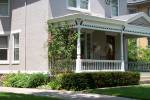Search engine visitors - click here to access entire "$ensible Home" web site
Click here to see a descriptive illustration of a climbing vine on a trellis and several houses with typical climbing plants.
Dear Jim: The afternoon sun gets intense and there is no room for shade trees. I thought about building a trellis for climbing vines for shade to lower my air-conditioning costs. It this a worthwhile project? - Taylor G.

A: Placing a trellis near your house and growing climbing vines is an effective natural method to shade and cool your home during the summer. By selecting the proper type of vines and designing the trellis properly, the winter sun will still shine through for natural passive solar heating.
Climbing vines can often be more effective than trees for shade because you can target specific windows and areas of your home where the heat is the greatest problem. Since the foliage of the vines is closer to your house than the leaves of a trees, the natural cooling effect is greater.
Planting flowering climbing vines can be an attractive addition to your landscaping. Every imaginable color of flower or bright berry is available. Several vines also have attractive foliage with unique shapes and colors.
Thick foliage on the vines can lower the surrounding air temperature by 10 degrees or more through transpiration. This is actual cooling from the moisture given off by the leaves. The vines trap this cool air to create a thermal buffer between the trellis and your house wall for energy savings.
The best choice is deciduous vines on the south and west exposures because they will lose their leaves in the winter. Select ones with an open vine pattern. Even without leaves, a heavy vine pattern may still block much of the winter sun. Evergreen vines on the northwest block winter winds too.
A trellis design that is simple is generally most effective for energy savings. A very ornate trellis looks beautiful, but after the leaves drop, they still block too much of the winter sun. A simple rectangular trellis built with lightweight lumber is effective and easy to make yourself.
It is very important to check the weather "hardiness zone" of each variety when selecting them. Not all varieties can survive severe winter temperatures or harsh summer conditions. The maximum length of a vine is also an important characteristic to be sure it will cover the entire trellis.
Two excellent groups of shading vines are ones that attach themselves with tendrils and ones that twine. Particularly with wood siding, avoid vines that attach directly to a wall because they may hold in moisture.
Twining vines are an excellent complement to a simple-to-build copper wire trellis. The vines will quickly grow and wrap securely around the copper wire. Copper weathers to a green patina, so it blends well with the vines.
Instant Download Update Bulletin No. 765- selector guide of 60 varieties of climbing vines (annual and perennial, flowering and non-flowering), climbing methods, common and botanical names, vine lengths, growth habits and characteristics, bloom times and colors, exposure,hardiness zones and a hardiness zone map of the U.S., illutrations and descriptions of the types and growth patterns of vines, and 10 mail-order vine seed suppliers.
Dear Jim: We don't seem to get much cooled or heated air out of the register in one of the bedrooms. Is there anyway that someone can determine if there is some kind of blockage in that bedroom duct? - Jay F.
A: First you should check the damper in that duct near the blower unit. It may be closed blocking the air flow. Don't just rely on the position of the handle. Test the air flow in both extreme positions.
After other testing, if you still suspect a blockage, some heating or duct cleaning contractors have small duct cams that they can feed into the duct to inspect it. Just call contractors in your yellow pages to find one with a cam.